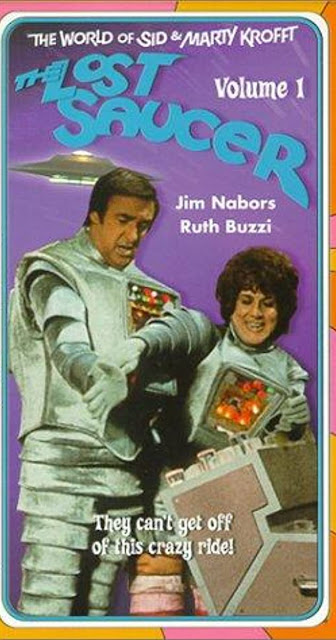THE
LOST SAUCER
(ABC, September 6-December 20, 1975)
Sid & Marty Krofft Television Productions
MAIN CAST:
Ruth Buzzi – Fi, Professor
Pringle
Jim Nabors – Fum, Doctor Locker
Jarrod Johnson – Jerry
Alice Playten – Alice
Larry Larsen - Dorse
The Lost Saucer was one of
two space-themed programs being developed by Krofft
Television Productions in 1975; the other being Far
Out Space Nuts. Those two shows marked a departure from the typical
Krofft formula with the toned-down use of puppet characters and the reliance on
guest-stars.
 |
| Jerry, Alice, Fi and Fum gathering fruit. |
Developed by Dick Morgan, the series
followed the adventures of two bumbling time-traveling androids from the year
2369: Fi (Ruth Buzzi) and Fum (Jim Nabors). They landed their flying saucer on
present-day Earth where they invited a young boy named Jerry (Jarrod Johnson)
and his babysitter Alice (Alice Playten) to check out their craft. However,
when their ship drew crowds the androids became nervous and took off with Jerry
and Alice. The Yearometer—the device that allowed them to travel to a specific
destination in time—ended up damaged, leaving them unable to return Jerry and
Alice to their proper time. The quartet proceeded to travel back and forth
through time, visiting Earth or one of its colonies at different periods and
interacting with the eccentric individuals that lived there. Along for the ride
was the only mascot costumed character, the Dorse (Larry Larsen): a half-dog,
half-horse hybrid who could talk. Nabors and Buzzi also played a dual role as
the creators of the androids, Dr. Locker and Professor Pringle (with Buzzi’s
being reminiscent of her character from Laugh-In).
 |
| A newly-hatched Chickophant inside the ship. |
The Lost Saucer debuted on ABC on September 6, 1975. The series was written
by Si Rose, Barry E. Blitzer,
John Fenton Murray, William J. Keenan, Larry Markes, John L. Greene, Arthur Phillips, Fred Fox and Seaman Jacobs,
with music by Michael
Lloyd. Each episode dealt with a specific theme and delivered a pro-social
message related to it often through the use of satire. They dealt with topics
such as obesity, blind conformity, wasting resources, narcissism, and
prejudice, among others. Nabors was a huge get for the show, as he had greatly
reduced his television presence following the cancellation of The Jim Nabors
Hour. Although he wasn’t sought after for his singing ability, a few song
numbers managed to be worked in for him. In a twist, Playten was hired
because of her singing ability; specifically, the Kroffts discovered her while
she was recording the theme song for ABC’s Funshine Saturday. To save on the
budget, sets were frequently redressed and reused in various episodes, and
costumes and props were borrowed from other programs. A lot of the futuristic
space technology was shared between Saucer and Space Nuts during
both shows’ productions.
 |
| The Lost Saucer VHS. |
The Lost Saucer ran
a single season of 16 episodes, during which time Nabors and Buzzi hosted ABC’s
Thanksgiving Funshine Festival in character. It remained on ABC’s schedule until
it was merged into The Kroft Supershow for the following season. The
first six episodes were rerun in slightly shortened versions until Supershow
was decreased to 60 minutes and Saucer was dropped. Saucer’s
first episode was included on Rhino
Home Video’s The
World of Sid & Marty Krofft VHS
collection in 1999, which was subsequently re-released
to DVD in 2002. Rhino also released a single
2-episode VHS of Saucer. In 2005, Rhino released a
stripped-down version of The World of Sid & Marty Krofft as Saturday
Morning with Sid & Marty Krofft.
EPISODE GUIDE:
“894X2RY713,
I Love You” (9/6/75) – In the far future, Jerry and Alice are arrested for not
having numbers and their faces exposed in public.
“The
Tiny Years” (9/13/75) – The saucer lands in a time when everyone is shrunken
and has a mistrust of anyone large.
“My
Fair Robot” (9/20/75) – Helping a bumbling robot leads Fi and Jerry to be
arrested as robot rustlers.
“Transylvania
2300” (9/27/75) – A mad scientist turns Fi and Fum into his slaves.
“Beautiful
Downtown Atlantis” (10/4/75) – The saucer crashes into Atlantis and its ruler
turns it into a TV station and Fi and Fum into the unwilling stars.
“Where
Did Everybody Go?” (10/11/75) – The saucer lands in a place where the ruler’s
paranoia caused him to turn all his people invisible.
“Get
a Dorse” (10/18/75) – In a time of depleted power, three scientists try to get
Dorse to operate a treadmill generator.
“Androids
Come Home” (10/25/75) – When the saucer returns home with Jerry and Alice, Fi
and Fum’s creators decide the androids must be recycled.
“Valley
of the Chickaphants” (11/1/75) – The saucer ends up in a time when people have
reverted to the Stone Age and half-chicken, half-elephant creatures roam.
“Return
to the Valley of the Chickaphants” (11/8/75) – The crew discovers that the
Dorse brought a chickaphant egg on board.
“The
Laughing Years” (11/15/75) – The androids are in trouble when they end up in a
place where not smiling is illegal.
“Fat
Is Beautiful” (11/22/75) – The saucer winds up in a land where physical
activity and being thin are outlawed.
“Planet
of Lookalikes” (11/29/75) – Fi and Fum are arrested for a traffic violation and
discover the civilization is comprised of clones of a narcissistic ruler.
“Fi
Am Woman” (12/6/75) – Fum gets amnesia and falls in love with a beautiful
android.
“Polka
Dot Years” (12/13/75) – The saucer malfunctions in a land where people without
dotted faces are discriminated against.
“Land
of the Talking Plants” (12/20/75) – Looking for food takes the saucer to a land
where plants have learned to speak.

No comments:
Post a Comment